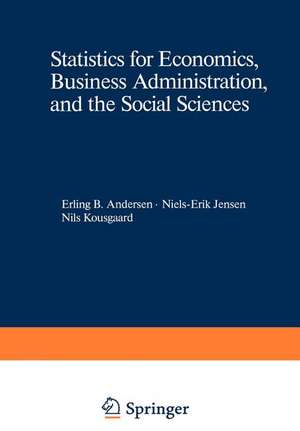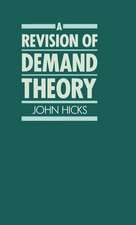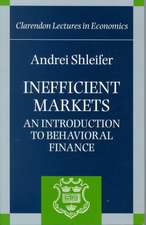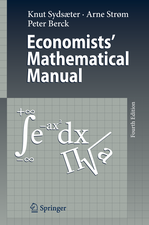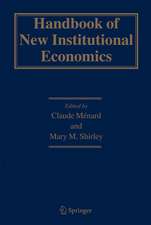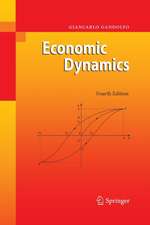Statistics for Economics, Business Administration, and the Social Sciences
Autor Erling B. Andersen, Nils-Erik Jensen, Nils Kousgaarden Limba Engleză Paperback – 29 apr 1987
Preț: 400.65 lei
Nou
Puncte Express: 601
Preț estimativ în valută:
76.67€ • 81.98$ • 63.92£
76.67€ • 81.98$ • 63.92£
Carte tipărită la comandă
Livrare economică 18 aprilie-02 mai
Preluare comenzi: 021 569.72.76
Specificații
ISBN-13: 9783540177203
ISBN-10: 3540177205
Pagini: 452
Ilustrații: XII, 440 p.
Dimensiuni: 170 x 244 x 24 mm
Greutate: 0.71 kg
Ediția:Softcover reprint of the original 1st ed. 1987
Editura: Springer Berlin, Heidelberg
Colecția Springer
Locul publicării:Berlin, Heidelberg, Germany
ISBN-10: 3540177205
Pagini: 452
Ilustrații: XII, 440 p.
Dimensiuni: 170 x 244 x 24 mm
Greutate: 0.71 kg
Ediția:Softcover reprint of the original 1st ed. 1987
Editura: Springer Berlin, Heidelberg
Colecția Springer
Locul publicării:Berlin, Heidelberg, Germany
Public țintă
Lower undergraduateCuprins
1. Introduction.- 1.1. Statistical methods.- 1.2. Examples.- 2. Descriptive Statistics.- 2.1. Data and variables.- 2.2. Description of the observed distribution of a categorical variable.- 2.3. Description of the observed distribution of a quantitative variable.- 2.4. Description of a grouped distribution of a quantitative variable.- 2.5. Linear relationship between two quantitative variables.- 2.6. Multiplicative and additive structures in two-way tables.- 3. Probability Theory.- 3.1. Observations and events.- 3.2. Combinations of events.- 3.3. Relative frequencies and probabilities.- 3.4. The axioms of probability theory.- 3.5. Conditional probabilities.- 3.6. Stochastic independence.- 4. Probability Distributions on the Real Line and Random Variables.- 4.1. Probability distributions on the real line.- 4.2. Random variables.- 4.3. Discrete random variables.- 4.4. Continuous random variables.- 4.5. Transformations.- 4.6. Empirical frequencies and density functions.- 5. Mean Values and Variances.- 5.1. The mean value.- 5.2. The variance.- 5.3. Theorems about mean values and variances.- 5.4. Other moments and distributional measures.- 5.5. Applications of location and dispersion measures.- 6. Special Discrete Distributions.- 6.1. The binomial distribution.- 6.2. The Poisson distribution.- 6.3. The Pascal distribution.- 6.4. The multinomial distribution.- 6.5. The hypergeometric distribution.- 7. Special Continuous Distributions.- 7.1. The normal distribution.- 7.2. The log-normal distribution.- 7.3. The exponential distribution.- 7.4. The Pareto distribution.- 7.5. The gamma distribution.- 7.6. A comparison of six distributions.- 8. Multivariate Distributions.- 8.1. Multi-dimensional random variables.- 8.2. Discrete m-dimensional random variables.- 8.3. Continuous m-dimensional random variables.- 8.4. Marginal distributions.- 8.5. Conditional distributions.- 8.6. Independent random variables.- 8.7. Mean values and variances for sums of random variables.- 8.8. The covariance and the correlation coefficient.- 8.9. The multinomial distribution.- 8.10. The distribution of sums of random variables.- 8.11. The multivariate normal distribution.- 9. The Distribution of Sample Functions and Limit Theorems.- 9.1. Introduction.- 9.2. The distribution of $$\overline {\rm{X}}$$ and S2 for normally distributed random variables.- 9.3. The t-distribution and the F-distribution.- 9.4. The law of large numbers.- 9.5. Limit theorems.- 10. Estimation.- 10.1. The statistical model.- 10.2. Estimation.- 10.3. Maximum likelihood estimation.- 10.4. Unbiased estimators.- 10.5. Consistency.- 10.6. The properties of ML-estimators.- 11. Confidence Intervals.- 11.1. Point estimates and confidence intervals.- 11.2. Confidence intervals.- 11.3. Confidence intervals for the mean value and the variance in the normal distribution.- 11.4. Confidence intervals for the parameters in the binomial distribution and the hypergeometric distribution.- 11.5. Approximate confidence intervals.- 11.6. Concluding remarks.- 12. Testing Statistical Hypotheses.- 12.1. The statistical hypothesis.- 12.2. Significance tests.- 12.3. Construction of tests.- 12.4. Tests in discrete distributions.- 12.5. Conditional tests.- 12.6. Approximate tests.- 12.7. The power of a test.- 12.8. Hypothesis testing and interval estimation.- 13. Models and Tests Related to the Normal Distribution.- 13.1. The u-test.- 13.2. The t-test.- 13.3. The Q-test.- 13.4. The comparison of two independent normally distributed samples.- 13.5. A model for pairwise observations.- 13.6. The model for pairwise observations and the model for two independent samples.- 13.7. The analysis of variance.- 13.8. Distribution free tests.- 14. Simple Linear Regression.- 14.1. Regression analysis.- 14.2. Simple linear regression.- 14.3. Estimation of the parameters.- 14.4. Properties of the LS-estimator.- 14.5. Analysis of variance.- 14.6. Interpretation of the estimated regression parameters and R2.- 14.7. Examination of the residuals.- 14.8. Predictions.- 14.9. Experimental and non-experimental data.- 14.10. Transformations.- 14.11. Comparison of two regression lines.- 15. Multiple Linear Regression.- 15.1. The multiple linear regression model.- 15.2. Estimation of the parameters.- 15.3. Properties of the LS-estimator.- 15.4. Residual analysis.- 15.5. Hypothesis testing.- 15.6. Case analysis.- 15.7. Collinearity.- 15.8. Predictions.- 16. Heteroscedasticity and Autocorrelation.- 16.1. Heteroscedasticity.- 16.2. Autocorrelation.- 17. Survey Sampling.- 17.1. Introduction.- 17.2. Simple random sampling.- 17.3. Simple random sampling in the binary case.- 17.4. Simple random sampling m the general case.- 17.5. Stratified sampling.- 18. Applications of the Multinomial Distribution.- 18.1. Hypothesis testing in the multinomial distribution.- 18.2. Goodness-of-fit tests of discrete distributions.- 18.3. Goodness-of-fit tests of continuous distributions.- 18.4. Comparison of k Poisson distributions.- 19. Analysis of Contingency Tables.- 19.1. The test of independence.- 19.2. The test of homogeneity.- 19.3. Comparison of binomial distributions.- 19.4. The multiplicative Poisson model.- 19.5. The effect of the sampling procedure.- 19.6. Analysis of the marginals of a two-way table.- 19.7. Three-way contingency tables.- Appendix Table.- Index of Examples with Real Data.
